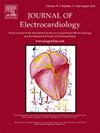阵发性心房颤动射频消融与低温球囊消融后p波参数变化的比较:一项观察性队列研究。
IF 1.3
4区 医学
Q3 CARDIAC & CARDIOVASCULAR SYSTEMS
引用次数: 0
摘要
背景:肺静脉隔离(PVI)治疗阵发性心房颤动(PAF)可采用一次性冷冻球囊消融(cryo)或逐点射频消融(RF)。本研究比较了两种烧蚀方法的p波参数变化。方法:本研究采用2018 - 2019年接触力RF和第二代冷冻技术进行单中心回顾性研究。手术成功的定义是12个月时心电图记录的房颤的自由度。在手术过程中直接监测带有1-50赫兹带通滤波器的数字12导联心电图。测量校正后的p波持续时间(PWDc)、p波电压(PWV)、p波色散(PWDisp)和V1的p波末端力(PTFV1),并比较RF和冷冻的差异。排除了肺静脉外的其他消融。结果:最终分析纳入226例患者,RF和冷冻12个月随访时房颤自由率相似(76% vs 74%, P = 0.12)。两组PWDc和PWV分别升高和降低。PTFV1减少射频(-3.3 mm.s mm.s至-4.6,P 1032 = 0.80, P = 0.85),采集(到1032 = 0.19,P = 0.06),和PWDisp(到1032 = 0.16,P = 0.34)和PTFV1 (P = 0.39)。PWDc升高与RF失败(风险比[2.3],95%可信区间[CI]: 1.4 ~ 5.9, p = 0.01)和冷冻失败(风险比:2.1,95% CI (1.3 ~ 4.6), p = 0.02)相关。当排除服用抗心律失常药物的患者时,结果相似。结论:射频和低温导致PAF患者12月房颤自由相似,p波参数变化相似。本文章由计算机程序翻译,如有差异,请以英文原文为准。
Comparison of P-wave parameter changes after radiofrequency ablation and cryoballoon ablation for paroxysmal atrial fibrillation: An observational cohort study
Background
Pulmonary vein isolation (PVI) for paroxysmal atrial fibrillation (PAF) can be performed using one-shot cryoballoon ablation (cryo) or point-by-point radiofrequency ablation (RF). This study compares the changes in P-wave parameters between both ablation methods.
Methods
This single-centre retrospective study included contact force RF and second-generation cryo for PAF between 2018 and 2019. Procedure success was defined by freedom of ECG-documented AF at 12 months. Digital 12‑leads ECGs with 1–50 hertz bandpass filters were monitored directly during the procedure. Corrected P-wave duration (PWDc), P-wave voltage (PWV), P-wave dispersion (PWDisp), and P-wave terminal force in V1 (PTFV1) were measured and compared between RF and cryo. Additional ablations outside pulmonary veins were excluded.
Results
The final analysis included 226 patients, and the freedom of AF rate was similar at the 12-month follow-up between RF and cryo (76 % vs 74 %, P = 0.12). PWDc and PWV increased and decreased, respectively in both arms. PTFV1 decreased in RF (−3.3 mm.s to −4.6 mm.s, P < 0.001) and cryo (−3.4 mm.s to −5.3 mm.s,P = 0.002). There were similar changes after RF and cryo in PWDc (F11, 1032 = 0.80, P = 0.85), PWV (F11, 1032 = 0.19,P = 0.06), and PWDisp (F11, 1032 = 0.16,P = 0.34) and PTFV1 (P = 0.39). Increased PWDc was correlated with failure of RF (hazard ratio [2.3], 95 % confidence interval [CI]: 1.4–5.9, p = 0.01) and cryo (HR: 2.1, 95 % CI (1.3–4.6), p = 0.02). Results were similar when patients on antiarrhythmic drugs were excluded.
Conclusion
RF and cryo caused similar freedom of AF rate at 12 months in PAF and similar P-wave parameter changes.
求助全文
通过发布文献求助,成功后即可免费获取论文全文。
去求助
来源期刊

Journal of electrocardiology
医学-心血管系统
CiteScore
2.70
自引率
7.70%
发文量
152
审稿时长
38 days
期刊介绍:
The Journal of Electrocardiology is devoted exclusively to clinical and experimental studies of the electrical activities of the heart. It seeks to contribute significantly to the accuracy of diagnosis and prognosis and the effective treatment, prevention, or delay of heart disease. Editorial contents include electrocardiography, vectorcardiography, arrhythmias, membrane action potential, cardiac pacing, monitoring defibrillation, instrumentation, drug effects, and computer applications.
 求助内容:
求助内容: 应助结果提醒方式:
应助结果提醒方式:


